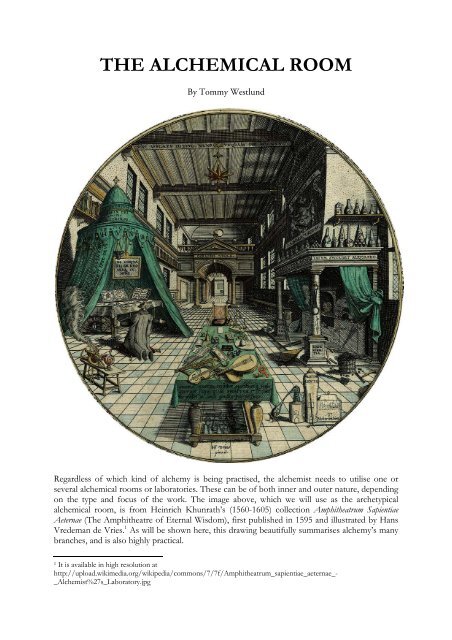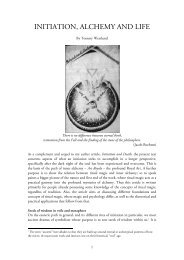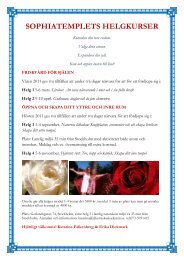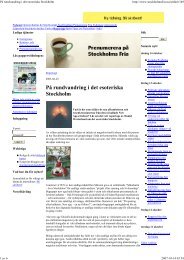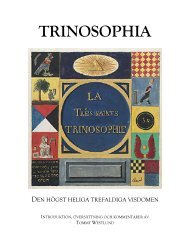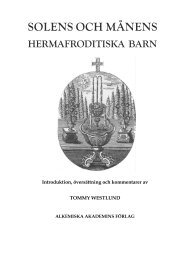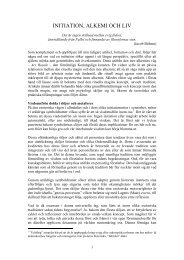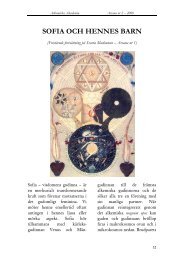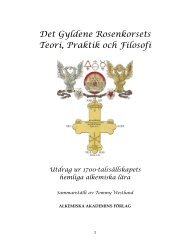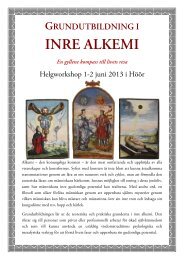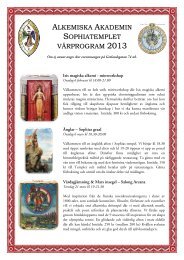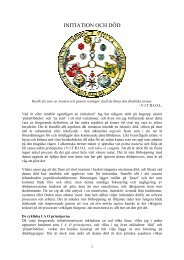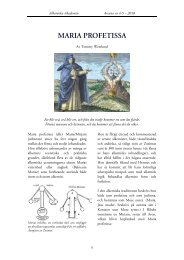The Alchemical Room - Alkemiska Akademin
The Alchemical Room - Alkemiska Akademin
The Alchemical Room - Alkemiska Akademin
Create successful ePaper yourself
Turn your PDF publications into a flip-book with our unique Google optimized e-Paper software.
THE ALCHEMICAL ROOM<br />
By Tommy Westlund<br />
Regardless of which kind of alchemy is being practised, the alchemist needs to utilise one or<br />
several alchemical rooms or laboratories. <strong>The</strong>se can be of both inner and outer nature, depending<br />
on the type and focus of the work. <strong>The</strong> image above, which we will use as the archetypical<br />
alchemical room, is from Heinrich Khunrath’s (1560-1605) collection Amphitheatrum Sapientiae<br />
Aeternae (<strong>The</strong> Amphitheatre of Eternal Wisdom), first published in 1595 and illustrated by Hans<br />
Vredeman de Vries. 1 As will be shown here, this drawing beautifully summarises alchemy’s many<br />
branches, and is also highly practical.<br />
1 It is available in high resolution at<br />
http://upload.wikimedia.org/wikipedia/commons/7/7f/Amphitheatrum_sapientiae_aeternae_-<br />
_Alchemist%27s_Laboratory.jpg
<strong>The</strong> image, called <strong>The</strong> First Stage of the Great Work, or <strong>The</strong> Alchemist’s Laboratory, is roughly divided<br />
into three areas; the oratory to the left, the laboratory to the right, and the musical and working<br />
table as well as the bed in the middle. To exemplify the nature of the work, a closer description<br />
and interpretation of the room and its contents will follow. <strong>The</strong> ensuing description of how such<br />
a room can be created follows the so called inner or spiritual alchemical path, but its use<br />
encompasses also other paths.<br />
<strong>The</strong> Oratory<br />
To the left, we see the alchemist in a praying position in front of a green prayer tent, his oratory.<br />
Alchemists have always emphasised the importance of prayer, and that it must precede and be<br />
part of the practical work, regardless of how that is being expressed. 2 <strong>The</strong> colour indicates a<br />
relation with the Emerald Tablet of Hermes, but also that the alchemical Opus is about greening<br />
nature. On its top we read: FELIX CVI, hwhy, A CONSILIS – Happy is the person who has God as<br />
counsel. Beneath we read: la hmkh – Wisdom of God. To the left of the entrance we read: HOC<br />
HOC AGENTIBVS NOBIS, ADERIT IPSE DEUS – When we attend strictly to our Work, God<br />
himself will aid us. Thus, all work should take place on the basis of a divine contact, both because it<br />
is only God who can fully unlock the alchemical mysteries, and also as a constant reminder that<br />
the alchemist shouldn’t be led by a simple gold desire of the ego or lower self. Thus is alchemy<br />
defined as the Royal path, which since the beginning of time has been imparted to adepts who<br />
have opened themselves unto the Wisdom of God, to investigate the mysteries of Nature and<br />
Creation.<br />
On the tablet which hangs from the ceiling of the oratory we read: NE LOQUA RIS DE<br />
DEOABSQ. LV.MINE – Do not speak about God without the Light. In front of it hangs a lamp, as<br />
an outer symbol of this Divine Light which shall illumine the work of the alchemist. Two books<br />
are spread open on the table; the one on the left with an encircled pentagram (on the left page)<br />
and an encircled triangle within a quadrant (on the right page). <strong>The</strong> pentagram is both a symbol<br />
for the microcosm, the small world, and the man made divine, and is associated with the planet<br />
Venus as well as with geometry. <strong>The</strong> triangle is a symbol for the divine trinity and the three<br />
alchemical substances. <strong>The</strong> quadrant alludes to the four elements, in which the three principles<br />
act. <strong>The</strong> book on the right side is the Holy Scripture, spread open on psalm 145. This is an<br />
acrostic psalm, where each verse (145:1-13b) begins with the successive letters of the Hebrew<br />
alphabet. Thus is alluded that the whole creation process is possible through alchemy. 3 Beneath<br />
the table are an hourglass and a skull under the inscription: DISCE BENE MORI – Learn to die<br />
well. This alludes both to the way of Nature, the principle of dissolution, and that even though<br />
alchemy promises eternal life, this nonetheless implies death of various forms. 4<br />
On the table to the bottom left side stand an incense holder and a seashell. Incense billows forth<br />
and fills up the room, and as a sacrifice the incense carries forth the alchemist’s prayers unto the<br />
throne of God. <strong>The</strong> seashell both alludes to a possible stoup (it can’t be seen whether it is filled<br />
with water or not), and to the receptive ability of hearing the voice of God. Another allusion is to<br />
the alchemical hermaphrodite, since many gastropods and scallops are hermaphrodites. Further,<br />
2 This is often expressed with the phrase ora et labora, pray and work. <strong>The</strong>se two aspects of the alchemical opus are<br />
symbolised by the left and right sides of the room.<br />
3 According to Kabbalistic lore, which has influenced and been influenced by alchemy, the 22 Hebrew letters are the<br />
foundation of Creation; the instruments through which God created everything that is.<br />
4 Compare this also with, for example, the Egyptian mysteries, where the initiate learned how to die while still in this<br />
life, and thus knew how the soul could traverse the regions of death and so enter into the presence of the eternal<br />
Gods.
the form is interesting, since it resembles the golden thread and forms the circular processes of<br />
alchemy as well as its double or polarising forces. 5<br />
<strong>The</strong> Laboratory<br />
<strong>The</strong> laboratory is on the right side of the room, where two pillars carry up an architrave, upon<br />
which stands alchemical bottles. Beneath is the alchemical oven or athanor. This athanor is<br />
designated for works according to the dry path 6 , where the three alchemical principles are forced<br />
into separation through a process of calcination, fusion, sublimation, conjunction, and dry<br />
distillation of the prepared matter. On the banner above we read: NEC TEMERE, NEC<br />
TIMIDE – Neither heedlessly nor timidly. This should always be the alchemist’s guiding word, and<br />
points out the importance of proper preparation, honest courage and serenity, and that the work<br />
concerns ones whole being. Neither too much nor too low fire, which of course relates to both<br />
inner and outer heat. On the architrave we read the exhortation: SAPIENTER<br />
RETENTATVM, SVCCEDET ALIQVANDO – That which is wisely retained will at length succeed.<br />
Certain operations need to be carried out during a long period of time, and the alchemist must<br />
then resist any temptation to interfere with the work, like opening the vessel, adding things,<br />
raising the fire etc. Inner and outer time is here of uttermost importance, and the inward<br />
processes that occur during that time. <strong>Alchemical</strong> operations may further need to be repeated<br />
several times before the sought result can be achieved. This can depend on the specific operation,<br />
that it requires a certain given amount of recurrence, but also that an inner condition or<br />
comprehension needs to be realised by the alchemist before the result can be manifested outside,<br />
in which case the quantity of recurrences depend on the alchemist.<br />
<strong>The</strong> bottles on the top row contain earth salt, heaven’s dew (ros deli), azoth (sophic mercury) and<br />
a sulphur solution. <strong>The</strong> second row contains bottles with potash (potassium carbonate), raw<br />
matter (hyle), dragon’s blood, potable gold, vinegar and mercury. All these are used in laboratory<br />
alchemy to dissolve, separate, purify and recombine chemical preparations, but they also have<br />
inner equivalences in the alchemist’s own being.<br />
<strong>The</strong> two pillars that lift up the architrave are inscribed with the words RATIO (reason) and<br />
EXPERIENTIA (experience). <strong>The</strong>y thus constitute the foundation upon which the alchemical<br />
Opus rests, and resembles the pillars of Severity and Wisdom. Behind the pillar of reason we see<br />
a cooling device with water. This points out the importance of being able to cool down ones<br />
reason, so that not only mental castles will be created. <strong>The</strong> reasoning mind is important but<br />
cannot be universally prevailing, just as intellectual study of alchemy makes no one an alchemist.<br />
A pair of bellows and tongs, to be used in the athanor, stands and lies next to the pillars, and<br />
show that a good balance between reason and experience shall govern the work. A bucket with<br />
coal is placed in front of the pillar of experience, and alludes to the necessity of studying both<br />
classical alchemical works as well as nature, as fuel for the Opus.<br />
Just to the right of the musical table stands a distillation still which separates the spirit (spiritus –<br />
mercury in the retort) from the soul (anima – the sulphur high up in the still) and the body (the<br />
salt which is remaining on the bottom). Next to it, and combined with it, is a smaller athanor for<br />
elixirs and the wet path 7 , with the inscription FESTINA LENTE – Hasten slowly. Apart from<br />
being a general alchemical axiom, it alludes that the elixir must be able to be heated by the fire<br />
5 Seashells are further often associated with pilgrims and pilgrimage (and Saint James the Great). <strong>The</strong> depicted shell,<br />
however, is not a scallop shell, wherefore this association is uncertain.<br />
6 In the dry path, the subtle principles are transferred from medium to medium through fusion, and it is therefore<br />
considered to be much shorter and more dangerous, not to mention warmer, than the wet path.<br />
7 <strong>The</strong> wet path produces a separation of the three principles through fermentation and exaltation, where a menstruum<br />
extracts the subtle principles. It is considered to be longer and safer than the dry path.
during one or several philosophical months 8 , which requires a gentle but steady fire. In the<br />
transparent vessel to the right of the athanor (with the inscription Maturandum – To mature), we<br />
see several bottles and retorts which are maturing, probably on a bed of sand 9 .<br />
<strong>The</strong> Mediator<br />
In the middle, linking together the oratory with the laboratory, we see a table with musical<br />
instruments (violin, lute, bell, etc.), writing materials, and a scale. This alludes to the three levels<br />
of music; the divine harmony, the music of the spheres, and the mundane music. Beneath the<br />
table is a storage of bottles, retorts, and a mortar. On the further end of the table is a chair, where<br />
the alchemist can rest, read, write and contemplate. <strong>The</strong> inscription on the tablecloth reads:<br />
MUSICA SANCTA tristia spiritúúm mali morum fúga gvili spiritvs hwhy totu ter psallit, ni cordi gaudio pio<br />
perfuso – Sacred Music, defence against sorrow and bad thoughts, because the spirit of God sings with threefold joy<br />
in the heart and imbues it with pious affection. Music, both as art and in its more divine aspect, thus has<br />
the ability to protect the alchemist from darkened thoughts and emotions during the hours of the<br />
symbolical night, when the mind starts to question whether the dawn ever will arise. This state of<br />
melancholy is described in multiple ways by both alchemists and mystics, and is symbolised in the<br />
Bible when Jesus spent forty days in the desert, tempted by the Devil. From a psychological<br />
perspective, it concerns meeting and integrating ones shadow, in either the dark night of the<br />
mind or of the soul.<br />
An even important fact is the vibrations of music, which stands in relation with the alchemical art<br />
of transmuting or changing. When a thing is caused to change its vibration, it can move on to or<br />
transcend into a new condition. And the same applies to man, who through vibration can not<br />
only change thoughts and emotions, but also gain mystical and transcendent experiences. In<br />
every day language, this is often described as charisma and people’s ability to change the<br />
atmosphere in a room just by their appearance.<br />
On the ceiling balk we read: SINE AFFLATU DIVINO, NEMO VNQUAM VIR MAGNUS –<br />
Without Divine Inspiration, there is no man who is great. This inspiration is directly related to the<br />
aforementioned vibrations, and it is thus only when these come from the Divine that man can<br />
truly transcend and become great. A lamp in the form of a heptagram with seven flames hangs<br />
down from the balk, which both alludes to the seven classical planets and the seven major<br />
operations of alchemy. A small bowl of light hangs from the lamp, showing that all planets and<br />
operations are permeated by the force of unity.<br />
Furthest away in the picture, we see an open door and a bedroom behind. <strong>The</strong> inscription on the<br />
arch above, DORMIENS VIGILA – Awake while sleeping – clearly states what should ever be<br />
focus of the alchemist. This is because the opus continues all the time and many revelations will<br />
occur in the dreams, if the alchemist has a wake consciousness. In a larger perspective this also<br />
alludes to the ever present conscious that never dies, constant weaving and dancing through the<br />
dream of life. This is sometimes described as the third condition of being, existing between the<br />
states of sleep and awake, and imperfectly termed as rapture. It is from this condition that the fine<br />
arts seek to express and mirror the beauty of Eternity, in which presence the alchemist works.<br />
Summary<br />
After this survey on Khunrath’s alchemical room, we can gain notions of all the elements which<br />
are present in, and constitute, the work of the alchemist. Dividing up the composition into three<br />
main areas also show how these relate to the three alchemical principles. <strong>The</strong> left side, the<br />
8 A philosophical month normally corresponds to 40 days.<br />
9 Sand beds are often used in alchemical work because of its capacity to hold an even heat during a long period time.
oratory, relates to the Divine Spirit and is thus associated with alchemical mercury H. It is the vital<br />
life-force 10 which exists in the air we breathe, the subtle feminine power, wherefore it is on the<br />
left or passive side on the drawing. <strong>The</strong> right side, the laboratory, has to do with consciousness<br />
and the soul, and is associated with alchemical sulphur F. It is the inner fire 11 , the subtle<br />
masculine power and the true will, and expresses character and colour. Since it is active, it is<br />
being illustrated on the right, active, side of the drawing. <strong>The</strong> middle part of the room, as well as<br />
the whole round form of the composition, is associated with alchemical salt G. It is the matrix<br />
or body wherein sulphur and mercury acts (and initially lies hidden), and is thus mediator,<br />
compound, fixity, tenacity and focus.<br />
Seen as an overall picture, the whole illustration constitutes the alchemical salt principle which<br />
contains everything that the alchemist initially seeks and needs in his opus, wherefore we also<br />
comprehend Khunrath’s title more fully, <strong>The</strong> First Stage of the Great Work. With this understanding,<br />
we can now seek to use this practically and show how an inner alchemical room can be created<br />
and utilised.<br />
<strong>The</strong> <strong>Alchemical</strong> Opus<br />
Alchemy, regardless of type, is partly about learning how to see beyond the surface, penetrating<br />
the illusory shell of separation which the mundane eye and mind interpret as reality, and partly<br />
about causing changes or transmutations in the various levels of existence. <strong>The</strong> alchemist seeks to<br />
learn and understand the secrets of man and nature, and how these correspond with the Divine;<br />
how everything consists of forces that collaborate and obstruct each other on several planes.<br />
<strong>The</strong>se hidden forces are separated and liberated through alchemical processes so that they,<br />
through transmutations, can be purified and brought back into a higher level of perfection or<br />
wholeness. In the outer, this can result as tinctures 12 , transmuted metals and the much famed<br />
Philosophical Stone. In the inner, mystical visions, self knowledge, energy work, Divine presence<br />
and the Stone of the Wise can be experienced and achieved. However, such a simple division<br />
becomes erroneous since it presupposes an opposition or separation between the outer and<br />
inner, something which the alchemist early on learns does not exist. By bringing something about<br />
on an outer plane, a similar effect happens on the inner plane, and vice verse. <strong>The</strong> one aspect<br />
presupposes the other aspect but is also its result. <strong>The</strong> inner and outer thus become as thesis and<br />
antithesis, which through the transmutation experience produces a synthesis where a higher form<br />
of perfection and wholeness is reached.<br />
A dependable method to learn how to see beyond the surface is by actively working with<br />
imagination and visualisation. Without getting lost in technical descriptions, it concerns the ability<br />
to create inner images, forms and connections with ones mind, which gradually have the ability to<br />
take on a more permanent condition in the sub-consciousness of the alchemist. As is well-known,<br />
many psychology schools utilise imagination to make contact possible between the pre-rational<br />
and transrational parts of the psyche, and in extension to crystallise the Higher Self.<br />
Based upon this survey of the alchemical room, and how the room as a whole constitutes the salt<br />
principle, it should be very obvious why the alchemist can utilise such a room to initiate and<br />
experience alchemical processes through contemplation and meditation. And although it is<br />
beyond the scope of this article, it can be worth mentioning that the alchemist concretely seeks to<br />
create a real body of salt, which extension can lead to the golden solar body. By creating and<br />
regularly working with the room, the zealous student will no doubt be able to unlock several of<br />
the mysteries concerning these bodies.<br />
10 Also termed alchemical eagle, chi, prana, etc.<br />
11 Not to be confused with the secret fire, which double aspects relate to philosophical salt.<br />
12 For body, soul, and/or spirit.
Creating the alchemical room<br />
<strong>The</strong> ability of the psyche to willingly create and hold on to inner images is sharply increased when<br />
being physically, mentally and emotionally relaxed. Thus, some kind of relaxation exercise should<br />
initiate the work, with calm and steady breathing cycles. A study of Khunrath’s illustration can<br />
then follow, where both the wholeness and certain details should be memorised. <strong>The</strong>reafter, to<br />
symbolically step down into the subconscious, a downward going stair with ten steps can be<br />
visualised, which leads to an old wooden door. Try to see the stairs as clear as possible with your<br />
inner eye, and when you are ready, step down one step and notice the change in your whole<br />
being. Seek to activate all inner senses. Walk down slowly, step by step, and be constantly aware<br />
of any sensations of a physical, intellectual, emotional or spiritual quality, without identifying with<br />
them. When you have reached the bottom, observe the mighty door which is inscribed with<br />
alchemical symbols, and seek to feel its power. Visualise a golden key hanging next to the door,<br />
grab it, unlock and open the door. A rather long dark narrow hall is behind, illumined by torch<br />
lights. Enter and close the door behind you. At the end of the hall you will see the alchemical<br />
room, and its clarity increases as you walk closer, until you are standing in it.<br />
To create a permanent form, seek to make the room as clear as possible. Walk toward the<br />
different sections, put on incense, sit down in prayer, play the instruments, feel the heat from the<br />
athanor, etc. Contemplate upon the admonitions and advices of the inscriptions, and try to<br />
comprehend their relevance from both a micro- and macrocosmic perspective. What can be done<br />
and experienced is only limited by ones imagination. <strong>The</strong> room becomes real when you allow it to<br />
be real, by regularly being and working in it. Other archetypical forms can then also be invited<br />
and manifested, according to your needs and the nature of the work. You should strive to make it<br />
as natural to be there as with any room in your mundane house. This is reinforced by linking<br />
together the inner and outer world; if you sit down to meditate, then also enter into your inner<br />
alchemical room and sit down for meditation there as well. When you go to bed, enter the inner<br />
room and lay down also on your inner bed. If you do not yet operate any kind of laboratory<br />
alchemy, notice that you can do that every time you make food. With one eye, be in your kitchen<br />
and cook, and with the other, be in front of your athanor and experience the inner processes of<br />
cooking. After having performed your work, you exit the inner room in the same way you<br />
entered it, according to your own needs. Initially, it is recommended to always exit the inner<br />
room, but as experience and knowledge increase, longer experiments can be performed. 13<br />
In a similar way, you can see the whole room in its salt principle as corresponding with your<br />
being, that which gives focus and constitute the matrix of existence, and that everything you<br />
experience occurs within this room. <strong>The</strong> right and left sides of the room then relates to the right<br />
and left side of your being, the active and passive part, the laboratory and the oratory. <strong>The</strong><br />
middle, the mediator, is like a pillar right through you, connecting above with below. Such a<br />
perspective can make it easier to experience how various occurrences relate to the alchemical<br />
principles, how the life force, consciousness and matrix flow through the ever present inner and<br />
outer interactions of existence.<br />
Both these procedures have the advantage, apart from the possibility of personal insights on the<br />
condition of existence, that the alchemical body of salt becomes stronger. Regular practises can<br />
thus transcend the wake and sleep of ordinary life into the before mentioned state of rapture. <strong>The</strong><br />
whole of existence becomes inspired and animated, and the illusory separation between spirit and<br />
matter, inner and outer, above and below can be transcended, and existence transmuted through<br />
13 It is quite easy to imagine moments and occasions when it is far from optimal to be in the inner room to a lesser<br />
or greater extent, when all focus is needed on the mundane plane.
the inner fire of love. <strong>The</strong> Great Work has then reached its beginning, and the mysteries of<br />
alchemy have started to be revealed.<br />
To experience the three alchemical principles<br />
Enter into the alchemical room. Allow the instruments to play the divine music of the spheres,<br />
and sit down on the pillar in the oratory. Experience the levels of your body; your physical body<br />
which sits or lies down, your inner subtle body that sits in the oratory, and the body which forms<br />
the alchemical room. Contemplate on how you utilise your body, how much you listen to or<br />
ignore its needs, to what extent it is the temple of your spirit. Experience the weight of your<br />
body, its ability to focus, and how the body in a bigger perspective is the matrix of life. Know<br />
that all this has to do with the alchemical salt principle.<br />
<strong>The</strong>n focus upon our consciousness, how it is separated from your body but yet is what<br />
experiences the various levels of the body. Experience the experiencer. In what way does your<br />
consciousness express itself in the various aspects of life Which colours are being shown in<br />
different situations, how does your consciousness change character depending on inner and outer<br />
circumstances To what extent do you express your true will Know that all this has to do with<br />
the alchemical sulphur principle.<br />
<strong>The</strong>n turn your awareness towards the vital life force which penetrates the whole of your being.<br />
Breath deeply and allow the spirit to fill you. Through spirit you are connected with everything,<br />
and within yourself it is expressed as your Higher or True Self. To what extent do you open<br />
yourself up to this contact with your essence How is it expressed in your life Rest in pure<br />
awareness, and allow it, alchemical mercury, to fully penetrate your whole being.<br />
Finally, meditate on the relation between these three principles; how the body is the mask of the<br />
soul, and how the soul is the body of the spirit.<br />
HOC HOC AGENTIBVS NOBIS, ADERIT IPSE DEUS.<br />
© 2009 Tommy Westlund


